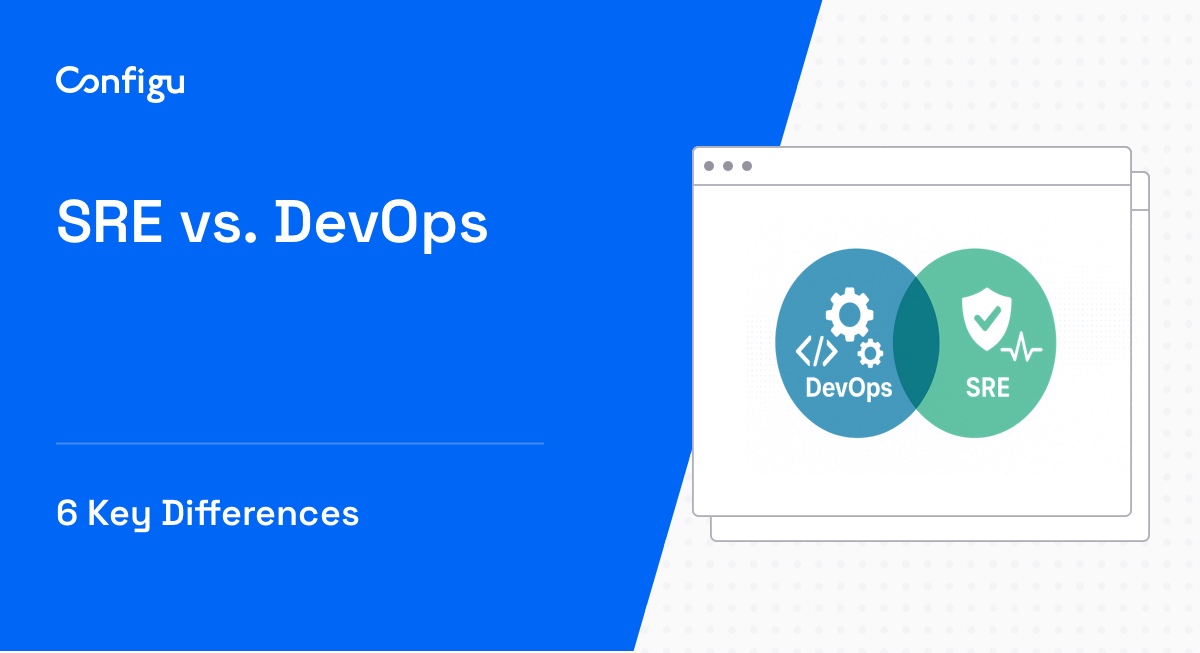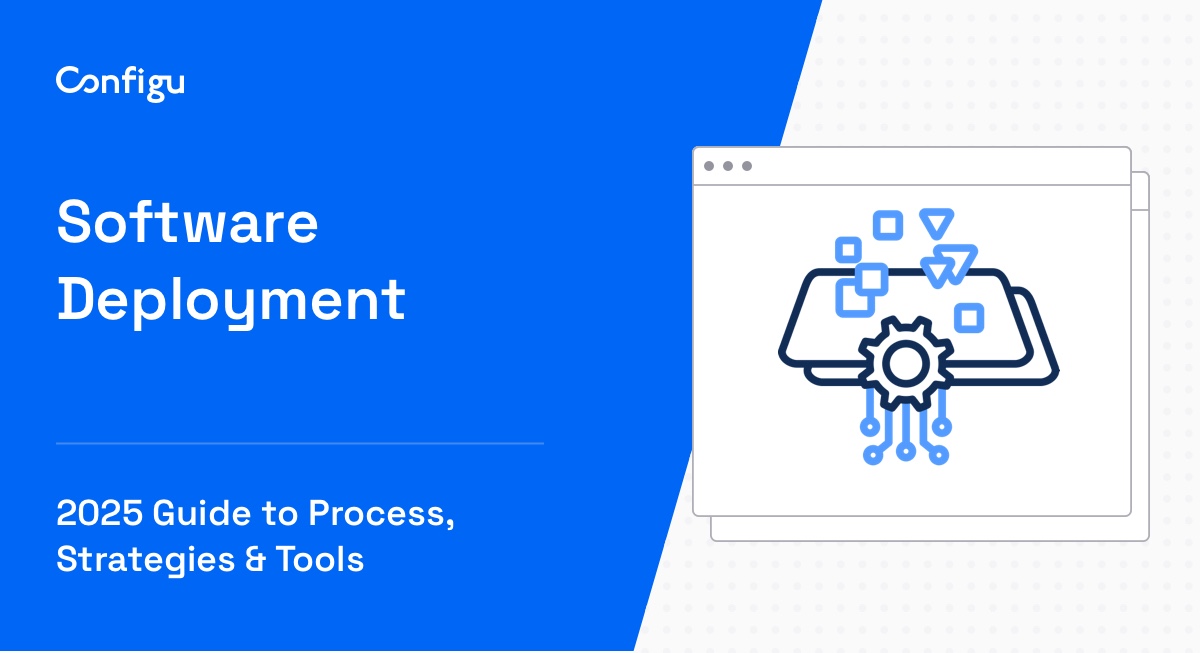What Is Application Configuration?
Application configuration involves specifying how an application behaves in different environments. This can include setting database connections, API keys, or toggling features on or off. Configuration provides the instructions that allow software to operate consistently under various conditions without requiring modification of the core code. It ensures that applications are adaptable and scalable, reducing the need for redevelopment when environments change.
Configuration is a crucial concept in software deployment and management. It acts as the bridge between code development and its execution environment. By separating configuration from code, developers can manage settings outside of the application itself, which simplifies updates and maintenance.
In this article:
Why Application Configuration Matters
There are several reasons that proper configuration of applications should not be overlooked.
1. Security and Compliance Advantages
Application configuration provides a way to manage sensitive data, such as API keys and database credentials, securely. By keeping these configurations out of the codebase, teams can enforce strict access controls, preventing unauthorized access.
Configuration management also helps in maintaining compliance with industry standards or regulations. For example, encrypted configuration files can satisfy data protection laws by ensuring that sensitive information is not exposed. Compliance checks can be automated to ensure that all environments adhere to the required standards.
2. Reducing Complexity Across Environments
Managing application settings across multiple environments can be complex. Configuration simplifies this by abstracting environment-specific settings away from the application code. This means that the same codebase can run in development, testing, and production environments, with only the configuration files being altered to suit each setup.
Reducing complexity through configuration also improves deployment speed and reduces the likelihood of errors. By setting clear parameters for different environments, it’s easier to maintain, test, and roll out applications, maintaining consistency across all stages of the software lifecycle.
3. Real-Time Updates and Scaling
Real-time configuration updates are essential for applications requiring rapid changes without downtime. With the right configuration management, updates can be applied dynamically, allowing for instantaneous changes without halting the application.
Scaling applications effectively is another advantage of configuration management. As user demands grow, configurations can be adjusted to allocate resources adequately, ensuring that the application continues to function optimally.
4. Global Collaboration
In a globally distributed development environment, configuration management supports collaboration by providing a centralized way to manage application settings. Team members across different geographies can access the same configurations, enabling a coordinated approach to application development and deployment.
Moreover, global collaboration through configuration management enables organizations to deploy region-specific features without modifying the global codebase. This capability allows companies to cater to localized content or functionality needs while maintaining the integrity of the application architecture.
Common Use Cases for Application Configuration
Here are some of the most popular examples of application configuration.
Feature Toggling and A/B Testing
Feature toggling is a configuration strategy that helps control which features are active in an application at runtime. By toggling features on or off via the configuration, developers can deploy new functionalities gradually and test them in live environments. This allows teams to mitigate risks associated with new releases and ensure only reliable features are fully launched.
A/B testing leverages configuration to experiment with different versions of a feature among user segments. This data-driven approach enables decision-making by providing insights into user preferences and behavior. Both feature toggling and A/B testing support an iterative development process.
Seasonal or Promotional Configuration Changes
Application configuration is pivotal in executing seasonal or promotional campaigns efficiently. Through configuration, organizations can schedule automated updates to roll out temporary design changes or content variations reflecting ongoing campaigns. These configurations can be predefined and enacted without needing additional deployment cycles.
Planning configuration changes for promotional periods helps organizations react quickly to market demands. This agility is especially beneficial for eCommerce platforms during peak shopping seasons, allowing organizations to stay competitive by adjusting offerings or appearances without technical delays.
Multi-Tenant Deployments Across Regions
For applications serving multiple tenants across various geographies, configuration provides a means to customize experiences while maintaining a single codebase. Configurations allow for regional customizations such as language and currency settings, offering localized experiences without duplicating code.
Configuration management supports the scalability and reliability of multi-tenant applications by simplifying the deployment process across different regions. By managing regional settings separately, teams can ensure that tenants have a consistent quality of service while efficiently handling region-specific requirements.
Tips From the Expert
In my experience, here are tips that can help you better optimize, secure, and scale your application configuration strategy:
- Use dynamic configuration reloading without restarts: Implement hot-reloading or polling mechanisms to detect and apply configuration changes at runtime without restarting services. This is invaluable in high-availability systems where uptime is critical, and enables fine-tuning behaviors dynamically.
- Build a configuration validation layer: Before applying any new configuration, validate it against a predefined schema or rule set (e.g., using JSON Schema or custom validators). This prevents invalid or risky config values from propagating to production environments.
- Create config drift dashboards across environments: Continuously compare configuration values across dev, staging, and production to detect drifts. Visual dashboards with diffing capabilities can quickly highlight inconsistencies, helping teams catch environment-specific bugs early.
- Implement configuration circuit breakers: For critical configs (like remote API endpoints or flags that alter core logic), introduce circuit breaker logic that reverts to safe defaults if unexpected or malformed values are detected during loading or usage.
- Adopt “config as a service” with service discovery integration: Provide configurations through a centralized API that integrates with service discovery. This enables microservices to retrieve environment-specific settings dynamically, supporting greater flexibility and real-time reconfiguration.
Components of Application Configuration
Configuration Files
Configuration files are one of the most common methods for defining application settings. These files typically use formats like JSON, YAML, TOML, or XML, and are loaded by the application at runtime. They store values for database connections, third-party service credentials, logging levels, and other operational parameters.
Because they are structured and human-readable, configuration files make it easy to maintain and version control settings alongside application code. This is especially useful in containerized or infrastructure-as-code environments, where configurations must align tightly with deployment scripts. Many applications also support hierarchical or environment-specific configurations, allowing overrides for different deployment targets.
Environment Variables
Environment variables provide a secure and flexible way to pass configuration data to applications. These are typically injected into the process environment at runtime by the operating system, container orchestrator, or CI/CD pipeline. Environment variables are useful for storing sensitive values such as API keys, secrets, and access tokens.
These variables avoid hardcoding sensitive data in files or code. They are widely supported across operating systems and languages and are often used in conjunction with twelve-factor app principles. By externalizing configuration through environment variables, applications can be made portable and environment-agnostic.
Command-Line Arguments
Command-line arguments allow users or automation tools to pass configuration values to an application when it starts. These arguments are typically used to override default settings defined in configuration files or environment variables, offering fine-grained control over application behavior.
They are particularly useful for scripts, testing tools, or local development workflows where quick changes are required without modifying persistent configuration. While less suitable for managing complex or sensitive configurations, command-line arguments are effective for toggling flags, setting temporary parameters, or launching apps in different modes.
Related content: Read our guide to configuration as code
Configuration Management Strategies
There are several different approaches to managing application configurations.
Centralized vs. Decentralized Configuration
In a centralized configuration model, all configuration data is stored and managed in a single, unified location such as a remote configuration server or centralized configuration repository. This approach is especially useful in distributed systems or microservices architectures, where maintaining consistency across services is critical. Centralized systems enable real-time updates, simplify change auditing, and reduce duplication of configuration logic.
Decentralized configuration involves each service or component managing its own configuration independently. This method can be simpler to implement in small-scale applications or when services are loosely coupled. However, it may lead to inconsistencies and make global changes harder to coordinate. Choosing between centralized and decentralized configuration depends on factors such as system complexity, team structure, and the need for consistency.
Configuration Hierarchies and Overriding
Configuration hierarchies allow systems to define default settings at a global level while enabling environment-specific or service-specific overrides. This layered approach helps reduce duplication and ensures flexibility across deployments. For example, a base configuration might define general logging levels, while a production override increases verbosity for troubleshooting.
Overriding mechanisms are usually supported by configuration libraries or frameworks, allowing configurations to cascade from broad to narrow scopes. Developers can override settings through environment variables, command-line flags, or additional config files loaded in a defined order.
Versioning and Change Management
Versioning configuration files is essential for maintaining traceability and supporting rollback capabilities. By storing configurations in version control systems like Git, teams can track changes, collaborate effectively, and audit historical settings. This is particularly relevant in regulated industries or complex production environments that require change documentation.
Effective change management involves reviewing, testing, and gradually rolling out configuration updates. This can be enabled through feature flags, staged deployments, or configuration management tools that support change promotion from development to production. Integrating configuration changes into CI/CD pipelines helps enforce governance and reduces the risk of introducing errors through manual edits.
5 Best Practices for Application Configuration
Here are some important practices to consider when configuring applications.
1. Segregate Configuration Data from Code
By externalizing configuration details, teams can decouple application logic, enabling environment-specific settings to be updated without code changes. This separation leads to more agile development processes and reduces the risk of introducing errors during updates.
Segregating configurations also supports a cleaner and more organized codebase, allowing developers to focus on functionality without managing environment-specific changes. This practice aligns with the twelve-factor app methodology, promoting an environment-agnostic codebase that fosters easy deployment across multiple cloud or on-premises environments.
2. Implement Strict Access Controls
Implementing stringent access controls for configuration data helps maintain application security. Access protocols should be defined and enforced to ensure only authorized personnel can modify sensitive configuration information. Role-based access control (RBAC) models can help delineate access permissions based on user roles, minimizing the risk of unauthorized changes.
Additionally, auditing and logging access attempts provide a trail for reviewing who accessed what configuration. Automated alerts for suspicious activity can preemptively identify potential threats, allowing teams to act swiftly to mitigate risks. Properly executed access controls are essential for protecting the integrity and confidentiality of configuration data.
3. Leverage Version Control for Configurations
Incorporating version control systems to manage configuration data offers substantial benefits, including improved transparency, accountability, and recoverability. By tracking changes to configurations over time, teams can swiftly identify when and why changes were made, simplifying troubleshooting and supporting operational efficiencies.
Version control systems enable easy rollback to known good configurations when issues arise, reducing downtime and minimizing the impact of configuration errors. The documented history of change equips teams with insights needed for informed decision-making and continuous improvement of configuration management strategies.
4. Automate Deployment Workflows
Automation in deployment workflows simplifies the application of configuration changes, ensuring that updates are applied consistently and reliably across environments. By automating these processes, teams can reduce manual errors and expedite deployment cycles, promoting quicker adoption of new configurations and enabling faster time-to-market for applications.
Deployment automation also improves scalability as applications grow and evolve. By integrating configurations directly into automated pipelines, teams ensure that configurations are always applied accurately, regardless of the environment or scale of deployment.
5. Monitor and Audit Configuration Changes
Continuous monitoring provides real-time insights into configuration actions, allowing teams to detect and address anomalies promptly. It is vital for ensuring system stability and performance by maintaining tight oversight of configuration activities.
Auditing creates a comprehensive record of configuration changes, offering vital information on who made each change, when, and why. Such a record supports compliance requirements and internal policies while enabling accountability and transparency.
Managing Application Configuration with Configu
Configu is an application configuration management platform comprised of two main components, the stand-alone Orchestrator, which is open source, and the Cloud, which is a SaaS solution:
Configu Orchestrator
As applications become more dynamic and distributed in microservices architectures, configurations are getting more fragmented. They are saved as raw text that is spread across multiple stores, databases, files, git repositories, and third-party tools (a typical company will have five to ten different stores).
The Configu Orchestrator, which is open-source software, is a powerful standalone tool designed to address this challenge by providing configuration orchestration along with Configuration-as-Code (CaC) approach.
Configu Cloud
Configu Cloud is the most innovative store purpose-built for configurations, including environment variables, secrets, and feature flags. It is built based on the Configu configuration-as-code (CaC) approach and can model configurations and wrap them with unique layers, providing collaboration capabilities, visibility into configuration workflows, and security and compliance standardization.
Unlike legacy tools, which treat configurations as unstructured data or key-value pairs, Configu is leading the way with a Configuration-as-Code approach. By modeling configurations, they are treated as first-class citizens in the developers’ code. This makes our solution more robust and reliable and also enables Configu to provide more capabilities, such as visualization, a testing framework, and security abilities.



